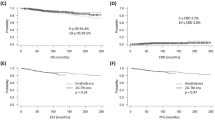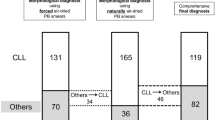Abstract
Imatinib Mesylate, a Tyrosine Kinase inhibitor, is presently the drug of choice for Chronic myeloid leukemia (CML). During therapy, a few patients develop myelosuppression and present with cytopenias. To study the bone marrow morphology in imatinib treated CML patients presenting with persistent cytopenias. The cases were retrieved from the Hematopathology record files, Department of Pathology; the study period being January 2008–June 2009. Cases of CML on Imatinib presenting with grade 2 or more anemia, neutropenia and/or thrombocytopenias with bone marrow studies, were included in the study. The morphology of all cases was reviewed with cytogenetic studies. Follow-up details were obtained from the Medical Oncology records. During the study period, 683 Imatinib treated CML patients had bone marrow studies as part of their follow-up investigations. Of these, 60 patients (9%) had some form of persistent cytopenia. The patients ranged from 21 to 75 years of age with a median age of 38 years. The male:female ratio was 1:1. There were 46 patients with ≥grade 2 anemia, 25 patients with ≥grade 2 neutropenia and 37 patients with ≥grade 2 thrombocytopenia. Of these, 18 patients had bicytopenia and 13 cases had pancytopenia. The marrow evaluation revealed morphologic response in 30 patients, persistent marrow disease in five patients, marrow hypoplasia in six patients, extensive stromal changes including fibrosis in five patients, megaloblastic erythropoiesis in 11 patients and disease progression to accelerated or blast crisis in three patients. Various degrees of cytopenias may occur in few patients of CML on imatinib therapy. Regular hematologic follow-up is required so that the drug may be stopped or dose modified as per the individual’s needs.







Similar content being viewed by others
References
Vardiman JW, Melo JV, Baccarani M, Thiele J (2008) Chronic myeloid leukemia, BCR-ABL1 positive. In: Swerdlow SH, Elias C, Harris NL, Jaffe ES, Pileri SA, Stein H et al (eds) WHO classification of tumours of hematopoietic and lymphoid tissues. IARC, Lyon, pp 32–37
Hasserjian RP, Boecklin F, Parker S, Chase A, Dhar S, Zaiac M et al (2002) STI571 (imatinib mesylate) reduces bone marrow cellularity and normalizes morphologic features irrespective of cytogenetic response. Am J Clin Pathol 117:360–367
Guilhot F (2004) Indications for imatinib mesylate therapy and clinical management. Oncologist 9:271–281
Frater JL, Tallman MS, Variakojis D, Druker BJ, Resta D, Riley MB et al (2003) Chronic myeloid leukemia following therapy with imatinib mesylate (Gleevec). Bone marrow histopathology and correlation with genetic status. Am J Clin Pathol 119:833–841
Braziel RM, Launder TM, Druker BJ, Olson SB, Magenis RE, Mauro MJ, Sawyers CL et al (2002) Hematopathologic and cytogenetic findings in imatinib mesylate-treated chronic myelogenous leukemia patients: 14 months’ experience. Blood. 100:435–441
Joshi S, Sunita P, Deshmukh C, Gujral S, Amre P, Nair CN (2008) Bone marrow morphological changes in patients of chronic myeloid leukemia treated with imatinib mesylate. Ind J Cancer 45:45–49
Sneed TB, Kantarjian HM, Talpaz M, O’Brien S, Rios MB, Bekele BN et al (2004) The significance of myelosuppression during therapy with imatinib mesylate in patients with chronic myelogenous leukemia in chronic phase. Cancer 100:116–121
Lokeshwar N, Kumar L, Kumari M (2005) Severe bone marrow aplasia following imatinib mesylate in a patient with chronic myelogenous leukemia. Leuk Lymphoma 46:781–784
Srinivas U, Pillai LS, Kumar R, Pati HP, Saxena R (2007) Bone marrow aplasia–a rare complication of imatinib therapy in CML patients. Am J Hematol 82:314–316
Khan KA, Junaid A, Siddiqui NS, Mukhtar K (2008) Siddiqui S Imatinib-related bone marrow aplasia after complete cytogenetic response in chronic myeloid leukemia. J Coll Physicians Surg Pak 18:176–178
Infection, reactive changes (2001) In: Bain BJ, Clark CM, Lampert IA, Wilkins BS (eds) Bone marrow pathology. Blackwell Science, Oxford, UK, pp 130–131
Ram R, Gafter-Gvili A, Okon E, Pazgal I, Shpilberg O, Raanani P (2008) Gelatinous transformation of bone marrow in chronic myeloid leukemia during treatment with imatinib mesylate: a disease or a drug effect? Acta Haematol 119:104–107
Kovitz C, Kantarjian H, Garcia-Manero G, Abruzzo LV, Cortes J (2006) Myelodysplastic syndromes and acute leukemia developing after imatinib mesylate therapy for chronic myeloid leukemia. Blood 108:2811–2813
Author information
Authors and Affiliations
Corresponding author
Rights and permissions
About this article
Cite this article
Paul, T.R., Uppin, S.G., Uppin, M.S. et al. Evaluation of Cytopenias Occurring in Imatinib Treated Chronic Myeloid Leukemia (CML) Patients. Indian J Hematol Blood Transfus 26, 56–61 (2010). https://doi.org/10.1007/s12288-010-0030-6
Received:
Accepted:
Published:
Issue Date:
DOI: https://doi.org/10.1007/s12288-010-0030-6




